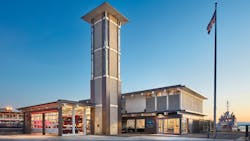Nestled among an abundance of shops and restaurants along the historic Seattle waterfront—including the legendary Ivar’s Fish Bar—you will find Seattle Fire Station 5. This popular fire station welcomes tourists and citizens alike and is the homeport of the fire department’s 108-foot-long fireboat, Leschi.
The fireboat was named after Chief Leschi, who was a chief of the Nisqually tribe. With the viaduct demolition nearing completion, downtown views to this Seattle landmark have recently been revealed and the number of visitors is expected to increase. The renovations to Fire Station 5 have made it more welcoming for the influx of pedestrian traffic.
A mid-century modern beacon, Fire Station 5 is a distinctive and recognizable fixture along the bustling waterfront promenade. One of the busiest stations in the city, it provides key services for a substantial portion of Seattle Fire Department’s downtown service area. As a base for landside and waterside response and rescue, the boats and gear for marine operations are unique aspects of the station.
As one of the most frequently visited fire stations in Seattle, firefighters regularly engage with the community. Visitors drop in to tour the facility and learn about the onsite equipment. Children delight in the fire trucks and fireboats. The large doors and windows along the front of the station offer inviting views from Alaskan Way—a busy street running along the waterfront—into the apparatus bay, foyer, office, and Puget Sound beyond, creating a welcoming and positive connection to the community. “This is one of the stations that is the pride of the organization,” notes Harold Scoggins, Seattle Fire Chief.
Built over 55 years ago, the fire station was constructed on Pier 53 to support the marine operations of Engine Company 4 and the land-based operations of Engine Company 5. Prior to renovation, the existing building was an extremely undersized (by 50% relative to peer facilities), program-deficient facility, but much loved by the two engine companies.
The fire station was in need of significant upgrades to meet current seismic, safety, and accessibility codes. In addition, it was one of the worst performing buildings in the entire Seattle Fire Department from an energy-use standpoint. Renovations for crew, administrative, and support areas were also needed. The station’s beanery opened onto the main access corridor from the marine docks to the station’s apparatus bay. The corridor was a main thoroughfare for operations, including transporting water rescues through the station to awaiting aid cars. This overlapping of disparate uses in the station needed to be corrected, but because it is a designated Seattle landmark, interventions needed to be sensitive to the building’s original character-defining features.
The renovation of Fire Station 5 occurred concurrently with portions of the Seattle Waterfront project, including the Elliott Bay Seawall replacement; SR99 Tunnel construction operations; and below-deck, marine-based structural work. Thus, the already small site was further constrained. Access from land was restricted since Pier 53 was briefly separated from Alaskan Way while the seawall was being rebuilt. Water access for the project was restricted by ferry operations and ongoing construction to the Colman Dock trestle, including building a temporary home for the King County Water Taxi immediately south of the Fire Station Pier.
Finally, at 6,000 square feet in size, the fire station itself has a substantially smaller footprint than current Seattle Fire Department standards, requiring an extremely efficient and creative design solution. While the Fire Station 5 crew enjoys visitors, the station was not laid out to accommodate large groups of guests while keeping daily operations separate and allowing firefighters privacy.
Solutions
The construction schedule required coordination with the demolition of the existing seawall, prior to its reconstruction. Through careful reexamination of the schedule, an innovative solution was discovered to capitalize on the specialized skills required for the Seawall Project.
The seawall contractor performed all marine work including:
- Core drilling the pier deck for plumbing and other conduit /utility locations
- Under-pier structural work, including seismic reinforcing of beams and repair of piers and beams
- Replacement of pier piles
- All connections to utilities
Due to the revised sequencing of work between the marine contractor and building contractor, the design coordination tolerances for the above pier work needed to be precise. Having the marine contractor mobilize a second time during the pier work and building renovations would have been costly and the budget did not allow that as an option.
The overwater structure of the existing concrete and steel pier severely limited design options for the systems in the building, particularly the locations of plumbing lines that penetrated the pier deck. Careful coordination of core drill locations with the pier deck structure was required to avoid the structural concrete grid of beams supporting the pier.
Some of the strategies used to support the City’s strong environmental sustainability ethic include photovoltaic panels and solar hot water heating. The rooftop panels are clearly visible as ferries enter Colman Dock, demonstrating the City’s commitment to renewable energy. This allows passersby and incoming ferry riders to appreciate the green elements of the building. Despite the building’s unique position over water, the implementation of high-performance windows and walls improved the thermal characteristics of the envelope and dramatically increased comfort for firefighters, while greatly decreasing noise transmission from busy Alaskan Way. Adding wall insulation and an insulated ceiling at the hose tower (now no longer used for hose drying), also improved energy efficiency. The project received LEED Gold certification.
Working closely with the Seattle Landmarks Preservation Board, Bassetti Architects proposed a modest addition of approximately 600 square feet, increasing the building’s footprint and allowing it to meet program requirements without significant impact to the historic exterior. This enabled the inclusion of an onsite physical training room and a more transparent and welcoming entry for the public, which is also a secured lobby to control access. Most importantly, the updated plan relocates the beanery to the second floor, along with all bunkrooms and lockers, creating a complete vertical separation of crew spaces (clean/calm/recovery) from operations (dirty/active/contaminated). This separation of activities creates a place of respite for firefighters and exceeds the owner’s expectation for the comfort of these important first responders.
The redesigned first floor areas are available for public tours and include the apparatus bay, offices, and maintenance areas. By providing open and inviting views into the apparatus bay from the main pedestrian and vehicular thoroughfare, a more transparent connection to the community is created. A graphic memorializing a 1927 fireboat previously housed at this site summons visitors from the community into the facility by engaging them with the history of the fire station.
A Station Worth Waiting For
Since this station was first built, the viaduct has always visually and physically separated it from downtown Seattle. Completion of the viaduct demolition will allow the station to assume its rightful connection to the reborn downtown waterfront, highlighting it as a beacon of public safety for the city and its visitors. People will have a more welcoming opportunity to learn about fire safety; children will be able to meet and become inspired by their local firefighters; and firefighters will continue to exhibit their hard work with offshore and onshore incident response.
Susan Conway is an Associate at Bassetti Architects and was the project manager and designer for the Fire Station 5 renovation.
About the Author

Susan Conway
Susan Conway is an Associate at Bassetti Architects headquartered in Seattle.
